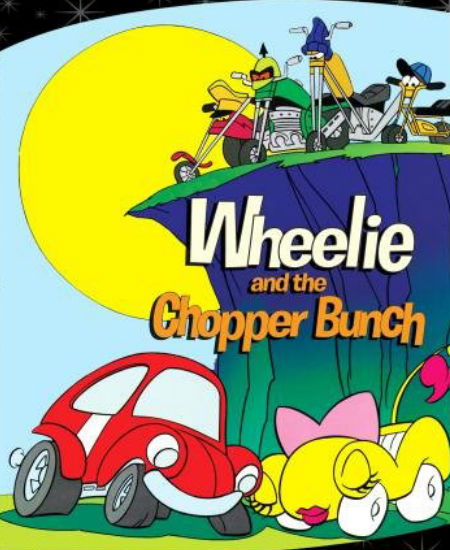
Cars good, motorcycles bad.
That seems to be the theme of Wheelie and the Chopper Bunch, an animated series from Hanna-Barbera which ran for 13 episodes from September 7, 1974 to November 30, 1974, and featured a land of sentient vehicles where the good guys were the cars and the bad guys were the motorcycles.
The series actually came in for some criticism at the time from critics who objected to the portrayal of motorcycle gangs and motorcyclists but honestly as a kid, I saw the show purely in terms of the fact that it was a cartoon in the spirit of Looney Tunes, in so far as its depiction of hijinks and violence, neither of which came with any real lasting consequence.
While the show was nowhere as sophisticated as Looney Tunes, it was amusingly-diverting, thanks to the ongoing attempt by the Chopper Gang, made of Chopper (voiced by Frank Welker), Revs (voiced by Paul Winchell, Hi Riser (voiced by Lennie Weinrib) and Scrambles (Don Messick), to get the best of dear, sweet Wheelie (Frank Welker) who communicates by beeps and whistles and cute emoticons on his windscreen.
He is the good guy of the piece, a well-meaning car, who has a gorgeous girlfriend Rota Ree (voiced by Judy Strangis), and who always, and I mean, always comes out on top.
Looking at from a purely adult perspective, the series is more than a little repetitive, but then to be fair so are the antics of Wile E. Coyote and Road Runner and we still laugh uproariously at them.
What’s often forgotten by adults looking at the simplicity of Hanna-Barbera’s cartoon series’ storylines is that for their intended demographic, kids, there was something reassuring about the fact that the Chopper Gang would try to bully and intimidate Wheelie, fail miserably and bested by our animated VW Beetle friend every time.
Sure, a little more narrative substance might have added to the series, which bore more than passing resemblance to two other Hanna-Barbera shows – Speed Buggy (1973) and Wonder Wheels (1977–78) – but as a kid propped on a pillow and in my pajamas on a Saturday morning, the series was pretty much perfect.
Not only was Wheelie likable but he was loved and looked after by many of the other characters in the show, and while I couldn’t have articulated it at the time, I loved the fact that he always bested the bullies, something I manifestly failed to do throughout my blighted time at school.
In fact, I spent my time being bested by the bullies, and while I tried to be friendly and relatable and all the nice things I actually was, no one seemed to care or change their behaviour towards me.
But Wheelie? Ah, Wheelie, adorable, kindhearted, genuine Wheelie not only beat the bullies, who were revealed to be consistently clumsy, incompetent and silly but he came out on top every time, the victor in a world whetre good doesn’t always beat bad.
This was the world of cartoons though where all the justice a kid who’s receiving none of it, socially at least (my family, thankfully were loving and nurturing) could want is available to a character who was rewarded for being a nice guy.
Again, I wasn’t sitting there in mid-1970s decoding all this as far as it affected me, but I think somewhere deep down, the fact that Wheelie was the one who always won out appealed to me on some deeply-appealing level.
Of course, I also loved the silly slapstick humour, the idiocy of the Chopper Gang, the Flintstones-esque renaming of towns to provide the requisite automative flavour – the Mojave Desert became the Motorjave Desert while San Francisco was rendered as Camshaft Cisco – and the general chase shenanigans that permeated each and every one of the episodes, which were divided into 3 segments, giving us 39 cartoons in all.
While the cartoon series itself only lasted for one season, it continued on in comic book, though not without some issues, as per Wikipedia:
“In 1975, comic book artist John Byrne was commissioned to create a series of books to coincide with broadcasts of the series. Published by Charlton Comics, it would also serve as Byrne’s first series of comic books. After the first issue was distributed in May 1975, Hanna-Barbera asked Byrne to create a mellower second issue, as the debut was considered “too scary” by executives. The second issue discouraged Byrne from continuing with the series, so he left after just two issues. Byrne also said he also felt wrong accepting the large amounts of money from Hanna-Barbera, which he stated was $50.00 per page.[19] The series continued with other artists.A total of seven issues were made, with the final one circulating in July 1976.”
I didn’t buy them as a kid but as an adult I’m in the process of trying to locate and buy all seven, providing me with another touchstone for a series that might be seen as simplistic by some, but which featured a warm, inviting world where the bullies didn’t win, the goodies did and I, as a beleaguered kid, could spend some time in a world blessedly different from my justice-deprived own.